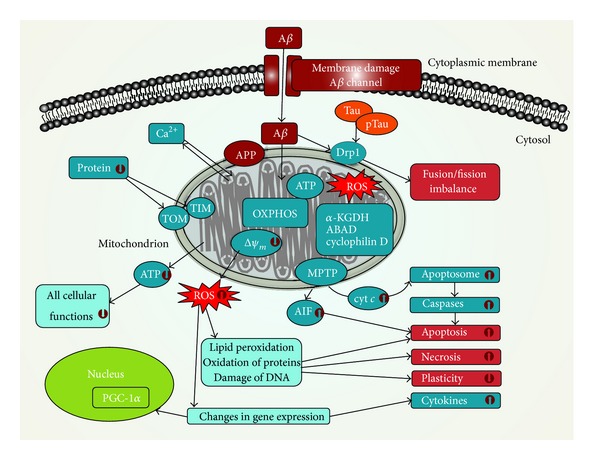Figure 1.

Mitochondrial dysfunctions in Alzheimer's disease. Amyloid-beta (Aβ) impairs the integrity of cytoplasmic membrane and causes mitochondrial dysfunctions. Aβ inhibits the activity of oxidative phosphorylation (OXPHOS) system, which can result in decrease of ATP production and increased reactive oxygen species (ROS) formation. Decreased ATP production leads to impairment of ATP-dependent processes, where all cellular functions are involved. Decrease of mitochondrial membrane potential (Δψ m) is followed by opening of mitochondrial permeability transition pores (MPTPs). Release of cytochrome c (cyt c) and other proapoptotic factors from the intermembrane space of mitochondria induces the formation of apoptosome and consequently triggers activation of caspases and apoptosis. Apoptosis inducing factor (AIF) is a proapoptotic factor released by mitochondria. Disengaged AIF is transported into nucleus and triggers caspases-independent apoptosis. Phosphorylated tau protein (pTau) and Aβ cause enhanced nitrosylation of dynamin-related protein-1 (Drp1) leading to impaired mitochondrial dynamics, increased mitochondrial fission, and neurodegeneration. Further, Aβ inhibits the import of proteins into mitochondria and reduces activity of mitochondrial amyloid-beta binding alcohol dehydrogenase (ABAD), α-ketoglutarate dehydrogenase complex (α-KGDH), and cyclophilin D. Ability of mitochondria to handle Ca2+ is impaired by Aβ and Aβ precursor protein (APP); consequently overload of mitochondrial calcium leads to decrease of Δψ m, opening of MPTPs, releasing of proapoptotic factors, increased ROS production, and decreased ATP production. PGC-1—peroxisome proliferator-activated receptor-gamma coactivator-1-alpha; TIM—translocase of the inner membrane; TOM—translocase of the outer membrane.
